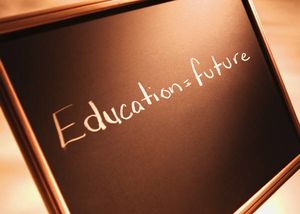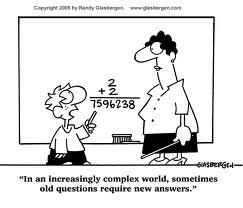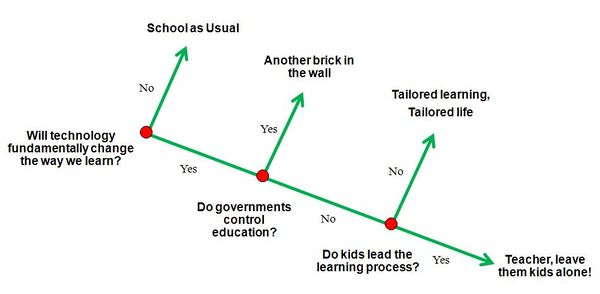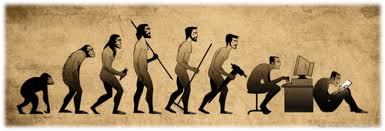Difference between revisions of "Future of Tablets in Education Main Page"
| (18 intermediate revisions by 2 users not shown) | |||
| Line 14: | Line 14: | ||
[http://nl.linkedin.com/in/neelssteyn Neels Steyn] <br> | [http://nl.linkedin.com/in/neelssteyn Neels Steyn] <br> | ||
==Introduction== | ==Introduction== | ||
| Line 33: | Line 24: | ||
What is the future of tablet technology in | What is the future of tablet technology in education in 2025? | ||
==Scenario Tree== | ==Scenario Tree== | ||
| Line 43: | Line 33: | ||
'''School as Usual''' <br> | '''School as Usual''' <br> | ||
In the School as Usual scenario we find that technology has yet again failed to enter the school system. Teachers resist to fully integrate tablets in the classroom while | In the School as Usual scenario we find that technology has yet again failed to enter the school system. Teachers resist to fully integrate tablets in the classroom while children�s extracurricular activates only involve technological gadgets and virtual worlds. This technological gap makes kids disengaged and distracted in school. | ||
'''Another brick in the wall''' <br> | '''Another brick in the wall''' <br> | ||
| Line 52: | Line 42: | ||
'''Teacher, leave them kids alone''' <br> | '''Teacher, leave them kids alone''' <br> | ||
In this world, technology has significantly changed the way that children learn. Governments are no longer the primary drivers of the education system, and students themselves lead the learning process. Learning content and curricula is driven largely by the student, with input and guidance from mentors and other facilitators. | In this world, technology has significantly changed the way that children learn. Governments are no longer the primary drivers of the education system, and students themselves lead the learning process. Learning content and curricula is driven largely by the student, with input and guidance from mentors and other facilitators. Kids� main source of learning � not only WHAT they learn but HOW they learn it shifts to themselves. | ||
==Scenario Stories== | ==Scenario Stories== | ||
| Line 61: | Line 51: | ||
[[Another brick in the wall]] <br> | [[Another brick in the wall]] <br> | ||
[[Tailored Learning, Tailored Life]] <br> | [[Tailored Learning, Tailored Life]] <br> | ||
[[Teacher, Leave | [[Teacher, Leave Them Kids Alone]] <br> | ||
==Interview Questions== | ==Interview Questions== | ||
| Line 111: | Line 101: | ||
[[File:System Diagram for Tabelt in Education 1.jpg]] | [[File:System Diagram for Tabelt in Education 1.jpg]] | ||
</gallery> | </gallery> | ||
==Scenario Timelines== | |||
<gallery> | |||
Image:Timeline_sau.jpg|''Timeline for School As Usual'' | |||
Image:Timeline_abitw.jpg|''Timeline for Another brick in the wall'' | |||
Image:Timeline_tltl.jpg|''Timeline for Tailored Learning, Tailored Life'' | |||
Image:Timeline_tltka.jpg|''Timeline for Teacher, leave them kids alone'' | |||
</gallery> | |||
==Driving Forces== | ==Driving Forces== | ||
| Line 156: | Line 157: | ||
Education complexity picture retrieved [[http://www.google.nl/imgres?imgurl=http://iwanbenneyworth.files.wordpress.com/2010/01/education-cartoon.gif&imgrefurl=http://iwanbenneyworth.wordpress.com/2010/01/&usg=__0UubjuX6qGPFzS8c-7hhDagPXvc=&h=457&w=534&sz=17&hl=nl&start=758&sig2=TatBrRquHwSrGjKkG7jpYg&zoom=1&tbnid=f5CIxBim1Cg62M:&tbnh=153&tbnw=179&ei=9LSITNnmC4f_Ofiy7JYD&prev=/images%3Fq%3Dtablet%2Bin%2Beducation%26um%3D1%26hl%3Dnl%26sa%3DN%26biw%3D1280%26bih%3D640%26tbs%3Disch:11,24281&um=1&itbs=1&iact=hc&vpx=530&vpy=305&dur=1650&hovh=208&hovw=243&tx=128&ty=131&oei=mrOITLytNYasOLKflM4H&esq=5&page=47&ndsp=17&ved=1t:429,r:13,s:758&biw=1280&bih=640 from]] <br> | Education complexity picture retrieved [[http://www.google.nl/imgres?imgurl=http://iwanbenneyworth.files.wordpress.com/2010/01/education-cartoon.gif&imgrefurl=http://iwanbenneyworth.wordpress.com/2010/01/&usg=__0UubjuX6qGPFzS8c-7hhDagPXvc=&h=457&w=534&sz=17&hl=nl&start=758&sig2=TatBrRquHwSrGjKkG7jpYg&zoom=1&tbnid=f5CIxBim1Cg62M:&tbnh=153&tbnw=179&ei=9LSITNnmC4f_Ofiy7JYD&prev=/images%3Fq%3Dtablet%2Bin%2Beducation%26um%3D1%26hl%3Dnl%26sa%3DN%26biw%3D1280%26bih%3D640%26tbs%3Disch:11,24281&um=1&itbs=1&iact=hc&vpx=530&vpy=305&dur=1650&hovh=208&hovw=243&tx=128&ty=131&oei=mrOITLytNYasOLKflM4H&esq=5&page=47&ndsp=17&ved=1t:429,r:13,s:758&biw=1280&bih=640 from]] <br> | ||
Tablet Evolution picture retrieved [[http://www.google.nl/imgres?imgurl=http://olliebray.typepad.com/.a/6a00d8341eb53c53ef0133f09b5397970b-500wi&imgrefurl=http://elgg.norfolk.e2bn.org/_rss/individual.php%3Ffeed%3D34&usg=__LyE1JsZJlgf_bcf_53HxKFUAJ8I=&h=170&w=500&sz=174&hl=nl&start=0&sig2=sFLvidCVEas6mA-gvC1TVQ&zoom=1&tbnid=YuUiBmhuGS4woM:&tbnh=70&tbnw=206&ei=Kr2ITODnK47fOJO9hIcO&prev=/images%3Fq%3Dtablet%2Bevolution%26um%3D1%26hl%3Dnl%26sa%3DN%26biw%3D1280%26bih%3D640%26tbs%3Disch:1&um=1&itbs=1&iact=hc&vpx=626&vpy=122&dur=1361&hovh=131&hovw=385&tx=200&ty=55&oei=Kr2ITODnK47fOJO9hIcO&esq=1&page=1&ndsp=17&ved=1t:429,r:3,s:0 from]] <br> | Tablet Evolution picture retrieved [[http://www.google.nl/imgres?imgurl=http://olliebray.typepad.com/.a/6a00d8341eb53c53ef0133f09b5397970b-500wi&imgrefurl=http://elgg.norfolk.e2bn.org/_rss/individual.php%3Ffeed%3D34&usg=__LyE1JsZJlgf_bcf_53HxKFUAJ8I=&h=170&w=500&sz=174&hl=nl&start=0&sig2=sFLvidCVEas6mA-gvC1TVQ&zoom=1&tbnid=YuUiBmhuGS4woM:&tbnh=70&tbnw=206&ei=Kr2ITODnK47fOJO9hIcO&prev=/images%3Fq%3Dtablet%2Bevolution%26um%3D1%26hl%3Dnl%26sa%3DN%26biw%3D1280%26bih%3D640%26tbs%3Disch:1&um=1&itbs=1&iact=hc&vpx=626&vpy=122&dur=1361&hovh=131&hovw=385&tx=200&ty=55&oei=Kr2ITODnK47fOJO9hIcO&esq=1&page=1&ndsp=17&ved=1t:429,r:3,s:0 from]] <br> | ||
Latest revision as of 23:06, 1 November 2021
Problem owner: Bernard de Groot, CIO Sanoma Learning & Literature
Bernard is also on [Twitter]
Team Members
Chun Seok Chang
Spyridoula Drakopoulou
Margo Martinez
Ines Ranguelova
Neels Steyn
Introduction
In this scenario set we explore the future of tablet technology in education. Neither the desktop PC/laptop, nor the internet have thus far managed to revolutionize the education system, in spite of the enormous potential these technologies hold for education. The excitement around tablet computers appears to be different though. We explore whether the penetration of tablets in the educational system will differ from that achieved by previous computing technologies. We also explore what form or manner this could possibly hold. In addition we broadened our research to explore whether technology, in general, will revolutionize the whole learning process. Our research focuses mainly on the EU region and refers both to primary and secondary education.
Focal Issue
What is the future of tablet technology in education in 2025?
Scenario Tree
Short Scenario Description
School as Usual
In the School as Usual scenario we find that technology has yet again failed to enter the school system. Teachers resist to fully integrate tablets in the classroom while children�s extracurricular activates only involve technological gadgets and virtual worlds. This technological gap makes kids disengaged and distracted in school.
Another brick in the wall
In this scenario,technology has fundamentally changed the way children learn. Moreover, the educational system is highly regulated and monitored by the EU governments. All EU countries have to abide to the uniform standards and rigorous testing imposed by the governments. Students are competing against each other in terms of performance as "student rankings" are published even at a daily basis. Students become highly competitive and aggressive due to the pressure to perform substantially better than their peers.
Tailored Learning, Tailored Life
In the Tailored Learning, Tailored Life scenario we find that technology has changed significantly the way education is delivered and the way that children learn. Governments no longer control the schooling or education system, but children do not lead the learning process themselves. Their learning is highly individualised and tailored to their specific talents, circumstances and interests.
Teacher, leave them kids alone
In this world, technology has significantly changed the way that children learn. Governments are no longer the primary drivers of the education system, and students themselves lead the learning process. Learning content and curricula is driven largely by the student, with input and guidance from mentors and other facilitators. Kids� main source of learning � not only WHAT they learn but HOW they learn it shifts to themselves.
Scenario Stories
School as Usual
Another brick in the wall
Tailored Learning, Tailored Life
Teacher, Leave Them Kids Alone
Interview Questions
Interview Questions explored with Bernard de Groot during an interview on 17 August 2010
Research Questions
Educational Systems around the world
Which are the main transformations that the educational system has gone through so far?
What is the total government spending for education? How much does it vary in the developing and developed world?
Which is the cost structure of schools?
What are the current technological trends in the educational system?
Demographic trends
What is the level of autonomy granted to schools/ What is the role of local ministries of education?
Is there any flexibility in the way the curriculum is structured and taught (alternative teaching methods)?
International initiatives for improvement of education
Tablets/Technology
- What are the different types of tablets on the market, price and volume?
- What are the various features/functions currently found on tablets available in the market?
- How long does it take for a technological innovation to increase its penetration rate?
- May the success of Apple affect the future of tablets and their popularity?
- PCs and laptops at schools. How have the penetration rates evolved through time?
- What are the benefits from using tablets, as opposed to laptops/PC's?
- Schools that currently make use of tablet computing and for which subjects/classes/purposes?
- Which is the receptivity of teachers and students concerning technology innovations and involvement of technology in the class?
- Obstacles in adopting tablets
Publishing Companies
Which are the main publishing companies worldwide?
How much power do these companies exercise compared to the other parties involved in the supply chain?
What is the current status of e-books and e-learning?
E-libraries
Open-textbook
Corporate role in Education
What is the involvement of corporations in the educational system currently?
Are there any partnership/ sponsorship between schools/universities and companies?
Systems Diagrams
Scenario Timelines
Driving Forces
1. Technological babysitting in Child Care (IR)
2. E-Books Usage (IR)
3. Decrease of Students' Engagement (SD)
4. Increasing Rate of Technological Change (NS)
5. Increasing Rate of Learning (NS)
6. Increasing Online Collaboration (MM)
7. Tailored and Alternative Learning Systems (MM)
8. Performance Measurement via Technology (MM)
9. Telecommunication technology (CC)
10. Education cost (CC)
11. Impact of the European sovereign debt crisis on education spending (NS)
12. Global Warming Threats (IR)
13. Decrease in competitiveness of EU (SD)
14. Increased number of teachers at retirement age (SD)
Key Group Learnings
- Group learning happens through language creation: By discussing and analysing the problem we created a terminology with a common understanding which allowed us create more surprising, plausible, deep and quality scenarios
- To build a good scenarios we dug deep below the surface by interviewing/watching people who had something interesting to say and challenge our way of thinking. In addition within the team we had diverse ways of thinking which helped for high quality scenario creation
- Scenario thinking is offering a new way of thinking. In our group that was mainly facilitated through challenging each others' ideas and defying assumptions that we were not even aware of
Web-Resources
Complete list of web resources.
References
Education=future picture retrieved [from]
Education complexity picture retrieved [from]
Tablet Evolution picture retrieved [from]








